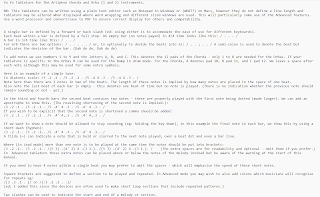A Tablature system for the Chorda and Orbas
After thinking about it for a while I have come up with a simple system for notating music on these devices. It was first thought up for Lead mode. It was written in Notepad and just to ensure the text doesn't get mangled being displayed on other systems I will show a .png file as well as the text content. Eventually I plan to make a pdf version.
This is my first draft and I forgot to mention that this notation will work just as well for all other modes. It doesn't really need any adaption for them.
Yo Yo Tablature for the Artiphon Chorda and Orba (1 and 2) instruments.
NB: This tablature can be written using a plain text editor such as Notepad in Windows or (WHAT?) on Macs, however they do not define a line length and tablature may be altered when displayed where word wrapping and different sized windows are used. This will particularly some use of the Advanced features. Use a word processor and convert/save to PDF to ensure correct display for others and compatability.
A single bar is defined by a forward or back slash (ed: using either is to accomodate the ease of use for different keyboards).
Each beat within a bar is defined by a full stop. An empty bar (no notes payed) in 4/4 time looks like this: / . . . /
A bar in 3/4 time like this: / . . /
For 6/8 there are two options: / . . . . . / or, to optionally to devide the beats into 3s: / . . ; . . / A semi-colon is used to denote the beat but indicates the devision of the bar. (Dah de de, Dah de de)
To add notes we use numbers 1 to 9 and the letters A, B, and C. This denotes the 12 pads of the Chorda - only 1 to 8 are needed for the Orbas. If your tablature is specific to the Orbas B can be used for the Bump in drum mode. For the Chorda, A denotes pad 10, B pad 11, and C pad 12. We leave a space after each note although this may be used for some extra symbols.
Here is an example of a simple tune:
In diatonic scale: /3 .2 .1 . /3 .2 .1 . /5 .4 4 .3 . /5 .4 4 .3 . /
Note here than there are 2 notes in two of the beats. The length of these notes is implied by how many notes are placed in the space of one beat.
Also note the last beat of each bar is empty - this denotes one beat of time but no note is played. (There is no indication whether the previous note should remain sounding or not - yet.)
In the third and fourth bars the second beat contains two notes - these are properly played with the first note being dotted (made longer). We can add an apostrophe to show this. (The resulting shortening of the second note is implied.):
/3 .2 .1 . /3 .2 .1 . /5 .4' 4 .3 . /5 .4' 4 .3 . /
If you wish to be explicit that the second note is shortened a comma should be added:
/3 .2 .1 . /3 .2 .1 . /5 .4' 4,.3 . /5 .4' 4,.3 . /
If we want to show a note should be allowed to stay sounding (eg: holding the key down), in this example the final note in each bar, we show this by using a short dash (hyphen):
/3 .2 .1-. /3 .2 .1-. /5 .4' 4 .3-. /5 .4' 4 .3-. /
A tilda (~) can indicate a note that is held or slurred to the next note played, over a beat dot and even a bar line.
Where (in Lead mode) more than one note is to be played at the same time the notes should be put into brackets:
/3 .2 .1-. /3 .2 .1-. /(5 3) .(4' 2) 4 .(3 1-). /(5 3) .(4' 2) 4 .(3 1-). / (The extra spaces are for readability and optional - omit them if you prefer.)
In Advanced tablature these extra notes can be placed above or below the notes of the melody instead but be aware of the warning at the start of this manual.
If you need to have 4 notes within a single beat you may prefer to omit the spaces - which will emphasise the speed of these short notes.
Square brackets are suggested to define a section to be played and repeated. In Advanced mode you may wish to also add colons which musicians will recognise for repeats eg:
/[3 .2 .1 . ]/ or /[:3 .2 .1 . :]/
(ed: I added this since the devices are often used to make short loop sections that include repeated patterns.)
Two slashes can be used to indicate the start and end of a melody or section.
Right click and save as if you want to keep the image version to hand.

Comments
Post a Comment